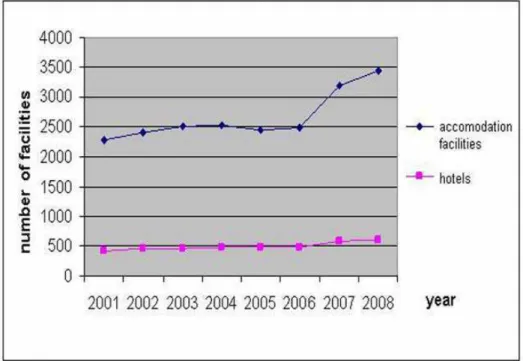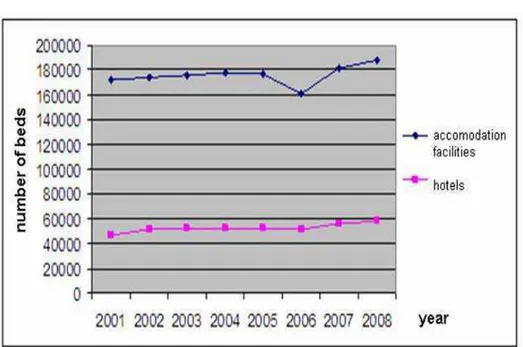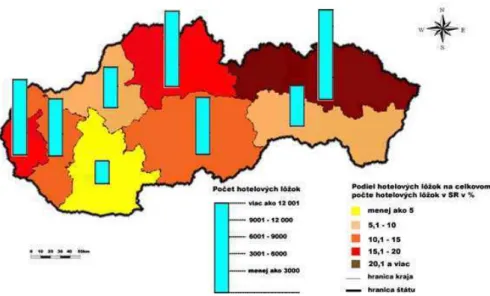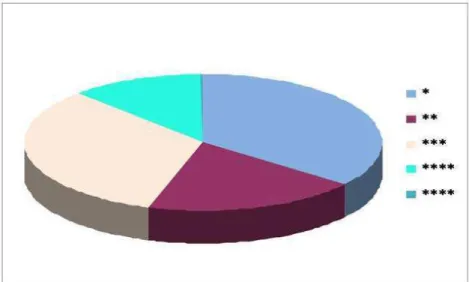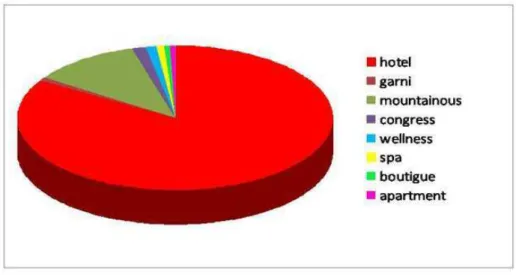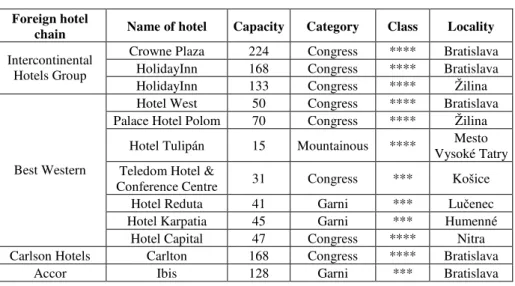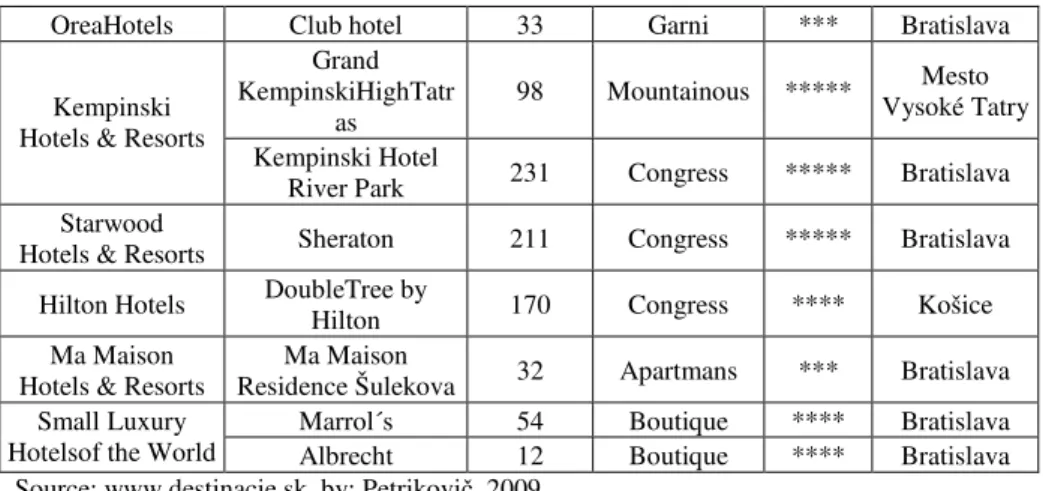GLOBALIZATION AND THE HOTEL INDUSTRY IN SLOVAKIA* ALENA DUBCOVÁ 1, JOZEF PETRIKOVIČ 1, LUCIA ŠOLCOVÁ 1
The development of tourism in the world and thus in Slovakia is influenced by globalization, which is one of the landmarks of the 21st century. Globalization starts when the internationalization of economic life develops in the space across the planet. Closely related to internationalization, it enforces the strict territorial framework that later grew into a wider world of space. The development of globalization processes stimulated by the scientific-technical revolution, the growing efforts to promote free trade through out the world, a principal change in many countries, which are accompanied by expansion of free business, capital,investment, the impressive development of telecommunications and transport networks, the option on fast-traveling to long distances, watching foreign television programs, understanding and using of foreign experience and practices contributed to the convergence of the world not only economically but also in other spheres.
Key words: hotel industry, globalization, hotel chain, tourism, the number of overnights.
Introduction
Creating a new universal lifestyle that interferes with fashion, music, food, human behavior, rest or recreation, globalization also means an increased international division of labor achieved through international fragmentation of production, as well as political trends towards a more liberal economic order (Smeral, 1998, p. 372 in Vesna Peris, 2005). Globalization is a multi-layered process in which the most important role is played by megacorporations and international companies. However this process also involves the small and medium business as well as the tourism industry customers. Tourism has become a big business and is operated by the big trusts. In tourism, globalization affects the demand and supply in several ways. The supply factors include, for example the usage of computer and reservation systems, the reduction of transport costs of traveling by airplane and other transportation to chosen destinations, new forms of management, exploring new destinations etc. As demand factors of globalization in tourism the rising of salary and of living
1 Constantine the Philosopher University in Nitra, Faculty of Natural Sciences, Department of
standards or the experience and education of tourists, interested in the new destinations may be included. Characteristic features of the globalization of tourism (Feig, 1998, in Peris, 2005) are:
Economy
• Horizontal and vertical integration strategies of tourism enterprises • Foreign investment in hotels and tourist attractions ("global tourism markets") • Global players and strategic alliances (air companies, hotels, tour operators) • Global tourism management
• Global competition of holiday resorts
Technology
• Global booking systems
• Standardized technologies in transport systems
Culture
• Global tourist: uniform traveller behaviour • Creation of "global tourist village"
Ecology
• Tourism as "global syndrome of ecology problem" • Climate changes and their effects on destinations
Politics
• Increasing importance of international tourism organizations
• Necessity for global coordination and regulation of passenger circulation • Sustainable development as quality and dominant idea
GLOBALIZATION AND THE HOTEL INDUSTRY IN SLOVAKIA 89
Hotel industry is related with activity of hotels, a hotel being defined as a property used for temporary accommodation for guests, which has more than ten rooms. Beside accommodation also catering and ancillary services, entertainment and community services, commercial passenger services and recreational sports services are part of the active leisure sphere. It is the services sector, which meets the individual needs of consumers. We see it as part of tourism which is also a prerequisite for its further development. The development of hotel industry is one of the main conditions for tourism development. Tourism and its sub-sector-hotel industry develop in paralel and influence each other. This dependence is twofold:
1. Dependency of tourism on hotel industry – without hotel business, there can be no residential tourism
2. Dependency of hotel business on tourism where the important factor is the capacity of hotel business and its development.
Globalization brings many new ways of business and especially in the hotel business, which are reflected in particular by creating new domestic hotel chains or by the introduction of foreign hotel chains that offer a higher standard of services, a new design and better equipment for hotels. They are all reflected in the brand and differentiate types of hotels.
The Current State of Hotel Industry in Slovakia
Although the hotel business in Slovakia has not a rich history as for example in the United States and the European countries like France or Germany, it achieved a comparable level with the hotel business in the neighboring countries. The transformation of the economy after 1989, allowed the changes in this sector. The largest hotels especially interhotel became independent (being used primarily in this period by foreign clients from the Eastern Bloc countries), for example Interhotel Bratislava, Interhotel Ružomberok Interhotel Tatras Starý Smokovec (which belong to the travel agency Čedok, on its turn subject of Ministry of Commerce of Czechoslovakia),
joins multinational hotel companies such as Accor, Carlson and Orea Hotels, which also established the right of the first hotels in Bratislava (Mištík, 2007).
Slovakia with its small area, but conveniently located in the heart of Europe and including rich natural and cultural attractions offers to visitors a constantly growing hotel market with increasingly higher quality standards for services. In 2008 in Slovakia there were 3434 accommodation establishments (with 57 860 rooms with a capacity of 187 698 beds), within which there were 596 hotels. The hotels were concentrating 27 465 rooms with a capacity of 58 357 beds, which accommodated approximately 2 357 603 of visitors more than half of tourists guested in the accommodation units (4 082 645 million of visitors). The number of overnights in accommodation establishments in Slovakia reached 12 464 104 tourists in 2008, of which 6 263 042 million overnights falls to hotels. The development of the hotel capacity recorded steady development without major fluctuations, which is characteristic for this sector (Fig. 1, Fig. 2).
GLOBALIZATION AND THE HOTEL INDUSTRY IN SLOVAKIA 91
Fig. 2. Development of bed capacity for the period 2001-2008
Hotels in Slovakia are quite unevenly distributed closely intertwined with tourism destination (Fig. 3). Almost half of hotels are concentrated in three
regions. Most hotels, up to 115-19% of the number of hotels in Slovakia, are situated in Žilina region which has interesting tourist, natural, cultural and historical areas such as Kysuce, Orava and Liptov. Prešov region follows with 103 hotels (17% of the hotels in the Republic of Slovakia), where the most beautiful and most visited mountains in Slovakia - High Tatras are located. The High Tatras concentrate the largest number of hotel beds in the Prešov region, which has a big available capacity (21,7%-12 673 beds) of hotel beds in Slovakia. The Tatras are followed by the Žilina region, accounting for 18,6 % of beds and being dominated with recreational hotel located in mountainous areas, in the major water areas (Orava, Liptovská Mara) or in regions with cultural and natural heritage. The third region in the number of hotels is the Bratislava region (88), its capacity being concentrated in the Slovak capital city Bratislava (66 hotels). Except from Bratislava, the city hotels are mainly represented in the larger regional cities (Košice, Banská Bystrica, Žilina, Prešov, Trnava, Trenčín, Nitra), satisfying the needs for short-term tourism and congress
tourism especially in spa towns (Piešťany, Bojnice, Bardejov, Trenčianske
Hotels visited by domestic and foreign clients reached 2 357 603 visitors in 2008. The view of the structure of tourist demand in Slovakia shows a dominant position for guests in the surrounding countries, especially from the Czech Republic (29,1%) and Poland (14,5%), followed by Germany (10,4%), Hungary (5,6%), United Kingdom (3,8%) and Austria (3,7%) (Fig. 5, Table 1).
Fig. 3. Hotels localization in the regions of Slovakia in 2008
GLOBALIZATION AND THE HOTEL INDUSTRY IN SLOVAKIA 93
Fig. 5. Share of hotel visitors of Slovakia in 2008
Table 1
Top 10 EU Countries in the Number of Overnights in Accommodation Facilities in Slovakia
Number of overnight stays State
2005 2006 2007 2008
Czech republic 1 569 835 1 510 855 1 610 881 1 704 632 Poland 786 430 722 596 762 890 941 975 Germany 724 877 698 452 777 872 682 274 Hungary 251 746 225 323 247 703 225 271 Austria 154 172 149 154 163 149 158 594 Great Britain 129 786 135 764 141 701 148 710 Italia 114 434 124 965 120 994 115 502
France 81 477 82 387 87 577 95 660
Romania 41 266 43 551 46 231 64 441
Netherlands 66 288 68 529 72 267 58 756 Source: www.destinacie.sk, Petrikovič, 2009.
Globalization in Slovak Hotel Industry
compatible because of rules set by the state or individual professional associations (Vavreková, 2007). The determining of the class of hotels in Slovakia is based on current legislation (decree no. 277 of June 26, 2008) which ranks hotels to 5 classes from * (one star) to ***** (five stars). The hotel structure is a relatively balanced ratio between hotels of lower category (the one star category claims for 104 – 17,45% of hotels and the following 2 star category for 149 - 25,0%) and the ones in the average category (of three stars – 249 – 41,78% of hotels) (Fig. 6). The frequency of hotels in higher categories is
about 15,77% (with 91 – 15,27% of hotels in the four stars and only 3 – 0,6% of hotels in the five stars category). The number of the hotels in the last category increased to 4 in 2011. In order to achieve maximum profits within the corresponding category (according to the focus – for example wellness, congress, spa hotels) the category is determined by the hotelier himself (Fig. 6).
Fig. 6. Level class hotels of Slovakia in 2008
Economic transformation and globalization has brought new trends also to the hotel ownership structure. Form of business may be independent or may be implemented through lease respectively through franchise agreements. Under the ownership structure hotels in Slovakia are divided in:
a) individual – hotel owner is a person or more persons, or a company with more managers (whether domestic or foreign capital) for example Hotel Sitno in Vyhne
GLOBALIZATION AND THE HOTEL INDUSTRY IN SLOVAKIA 95
Tatras), which is owned by a Slovak company J & T Hotel Management, but the operator is a German company Kempinski Hotels A.G.) c) hotel chains – owner and operator is an international hotel chain for
example Hotel Ibis in Bratislava. Hotel chains consist of two or more hotels. Today visitors pay attention, while choosing hotels offer, to more complex aspects – they are interested in luxury, comfort, relaxation, but also in the opportunity to combine business duties with a pleasant evening relax in the hotel. These preferences create new types of hotels which attract globalization and foreign capital, depending on the type of the offered services (e.g. garni, mountainous, congress, wellness, spa, boutique, apartment hotel). In the hotel structure hotels have only 16,44% (98 hotels), but their importance and frequency increases. They consist of hotels ranging from one to five stars (Fig. 7).
Fig. 7. Hotels category in 2008
Skala (Žilina), Golden Royal Boutique Hotel, Boutique Hotel Rokoko, Hotel Bristol, Hotel Maraton (Košice) or Hotel Zlatý Kľúčik (Nitra) may be mentionned.
An important tradition in Slovakia has the spa hotel segment that belongs to class hotel with three stars and more. They offer a range of services provided for the relevant class hotel offering medical care for the guests. They are located in the spa centers. These include e.g. Thermia Palace, Balnea Esplanade, Balnea Palace (Piešťany), Aphrodite Hotel, Hotel Veľká Fatra (Rajecké Teplice), Hotel
Krym, Hotel Flóra, Hotel Atlantis (Piešťany), Morava Hotel, Hotel Central
(Smrdáky), Hotel Astória, Hotel Ozón (Bardejov), Hotel Jantár (Dudince) and Grand Hotel Strand (Vyšné Ružbachy). The newer types of hotels in spa center and cities belong to wellness hotels that are especially designed for specific short-term stays associated with professional care and rehabilitation of guests. A newer type of hotel include wellness hotels, which are not only equipped with sporting and recreational facilities, but also provide a rational diet. The three star class and the upper class include for example Patince Wellness Hotel, Hotel Park (Piešťany), Hotel Comfort (Nitra), Hotel Rubín (Dudince) Hotel Termál
(Vyhne), Wellness Hotel Diplomat (Rajecké Teplice) and Hotel Aquacity Mountain View (Poprad), etc.
Another type of hotel, located in a natural environment is represented by mountain hotels, which include all classes except the one of four stars. They are located mainly in the central, northern and northeastern part of Slovakia. The most famous mountain hotels include, for example Hotel Šachtička (Banská
Bystrica), Golf Hotel (Tále), Sport Hotel Donovaly, Hotel Poľana (Hriňová),
Hajnice Mountain Hotel (Horný Vadičov) Mountain hotel Mních (Bobrovec),
Sliezsky dom pod Gerlachom (High Tatras), Mountain Hotel Hutník (Krompachy), Hotel Polianka (Krpáčovo) or Hotel Podjavorník (Papradno). In
the mountain areas there are also apartment hotels which consist of a minimum of eight apartments. They provide a range of services relevant for the class hotel and include as examples e.g. Apartment Hotel Liptovský Dvor (Liptovský Ján), Apartment Hotel Vili (Tatranská Lomnica), Hotel Vila Grand (High Tatras) and Hotel Crocus (Štrbské Pleso). Apartment hotels have been also created in urban environment e.g. Hotel Residence MaMaison (Bratislava), Hotel City Residence (Košice), Hotel Darmoon, Adam Eva Resort (Piešťany) and apartment hotels
Tatran and Magura (Donovaly).
GLOBALIZATION AND THE HOTEL INDUSTRY IN SLOVAKIA 97
Hotel Patria (Štrbské Pleso) Grandhotel Jasná, Grandhotel Starý Smokovec (Starý Smokovec), Congress Hotel Gala (Sielnica), Doubletree by Hilton (Košice) and Grand Hotel Kempinski High Tatras (Štrbské Pleso).
These new hotels brought foreign capital which entered the hotel industry through independent companies or through chains. The making of chains in the hotel industry is also one of the elements of globalization. Slovakia has traditionally been conservative, concentrating especially on small and medium-sized hotels that have private owners who keep guests through the familiar name of the hotel, which represents a guarantee of quality services. In Slovakia independent hotels dominate, whereas in the global hotel sector even 30% of all shares in the hotel industry are control by hotel chains. It is expected that in 2050 more than 60 % of the hotels will belong to multinational companies (Gúčík-Šípková,
2004). We know transnational (global) and national hotel chains, which benefit from the advantages of connection to the global distribution systems The hotel chain is a hotel group connected by one hotel brand or a group of hotels acting under a multi-brand label, so that their brands cover most market segments and are mutually complementary (Mištík, 2007), under agreements between hotels and the owner of rights of the hotel brand. The owner of the hotel company brand provides hotel services in a certain sphere, which is achieved by centralizing cost savings more efficiently. In Slovakia hotel chains are:
a) transnational – hotels with an international brand (3,34% of the hotels in Slovakia) – which are located in attractive regions of Slovakia, b) national – domestic hotel chains – with a small number of hotels – often
are not typical hotel chains (Table 2).
Table 2
Basic Indicators of Multinational Hotel Chains in 2008
Foreign hotel
chain Name of hotel Capacity Category Class Locality
Crowne Plaza 224 Congress **** Bratislava HolidayInn 168 Congress **** Bratislava Intercontinental
Hotels Group
HolidayInn 133 Congress **** Žilina Hotel West 50 Congress **** Bratislava Palace Hotel Polom 70 Congress **** Žilina
Hotel Tulipán 15 Mountainous **** Vysoké Tatry Mesto
Teledom Hotel &
Conference Centre 31 Congress *** Košice Hotel Reduta 41 Garni *** Lučenec
Hotel Karpatia 45 Garni *** Humenné Best Western
Hotel Capital 47 Congress **** Nitra Carlson Hotels Carlton 168 Congress **** Bratislava
OreaHotels Club hotel 33 Garni *** Bratislava Grand
KempinskiHighTatr as
98 Mountainous ***** Vysoké Tatry Mesto Kempinski
Hotels & Resorts
Kempinski Hotel
River Park 231 Congress ***** Bratislava Starwood
Hotels & Resorts Sheraton 211 Congress ***** Bratislava
Hilton Hotels DoubleTree by Hilton 170 Congress **** Košice
Ma Maison Hotels & Resorts
Ma Maison
Residence Šulekova 32 Apartmans *** Bratislava Marrol´s 54 Boutique **** Bratislava Small Luxury
Hotelsof the World Albrecht 12 Boutique **** Bratislava Source: www.destinacie.sk, by: Petrikovič, 2009.
Transnational hotels create closed or open strings. All hotels that are part of the chain must meet the same level of comfort and service. Hotel chains such as InterContinental Hotels Group (UK), Cendant (U.S.), Accor (F) and Hilton Corporation (U.S.) are famous examples of closed hotel chains. Management of such branded hotels is usually associated with compliance with standardized services and with providing a similar product in all of hotels belonging to one brand in several world countries. The second type of chains is called open strings. They are untypical international hotel chains, which combine independent hotels and form a consortium under a common brand. Through the individual hotels a freedom of choice is provided. This type of chain benefits from joining the group including brands such as e.g. Best Western (Fig. 8).
GLOBALIZATION AND THE HOTEL INDUSTRY IN SLOVAKIA 99
Slovak territory has its hotels in 10 international hotel chains and their number is growing. The first chain InterContinental Hotels Group came to Slovakia in 1990, in the capital city – Bratislava and built Forum Hotel, which under a management contract since 2005 was converted into Crowne Plaza Bratislava. The chain is characterized by multi-brand operation. Since 1995 under a franchise agreement the brand Holiday Inn operates in Bratislava. Holliday Inn is a brand of mid-level hotels. The second hotel of this brand is located in Žilina. InterContinental Hotels Group chain in Slovakia has an available capacity of 525 rooms including 133 rooms in Žilina. Unlike the InterContinental Hotels Group chain Best Western International operates in the global marketplace under one brand: Best Western. Its hotels are mostly minor independent units. This hotel chain in Slovakia has the largest number of hotels, located in Bratislava (Hotel West the member of Best Western since 1999) Bučeková (2007) but also in other
several cities – Palace Hotel Polom – Źilina –Tulipán Hotel – Tatranská Lomnica,
Hotel Teledom & Conference Center – Košice, Hotel Reduta – Lučenec, Hotel
Karpatia – Humenné and Capital Hotel in Nitra. Its total capacity is of 273 rooms. The chain of luxury hotels is represented by StarwoodHotels and Resorts famous with more brands. In 1999 the brand W Hotels was launched, which became the first successful hotel chain in the segment of boutique hotels. In 2005 Starwood has changed the strategy from the estate of the owner towards franchising and hotel management. On the territory of Slovakia string came in 2010 and is represented by one of the Sheraton Hotel in Bratislava with 211 rooms. By one hotel with 168 rooms the chain of Carlson Hotels is also represented. In Europe, The Rezidor Group subsidiary based in Brussels, has exclusive franchise rights for most brands of the company. For embacious clients MaMaison Hotels & Residencessie chain was designed, which consists of mainly medium-high luxury hotels of boutique & business class and conference hotels, as well as of residential all-suites hotel, meeting and exceeding the international standards requirements. As an example MaMaison Residence Šulekovo with 32 rooms represents a small hotel near Bratislava. Other international chains in Slovakia as Kempinski Hotels and Resorts are among the oldest in Europe (1897). The brand represents the hotels that are oriented to embacious clients in the field of recreation and tourism employment. It is represented by the five star Kempinski Hotel River Park in Bratislava. This city conference hotel was opened in 2010. Another example, Hotel Grand Kempinski High Tatras in Štrbské Pleso is a luxury mountainous hotel, which was built in 2009.
chain is Small Luxury Hotels of the World that does not produce typical international hotel chains, but consists rather in an association of hotels, focusing on common standards and trends. In Slovakia this association owns two hotels in Bratislava e.g. Marrol (54 rooms) and Albrecht (12 rooms). International companies have their hotels OreaHotels in Slovakia, which is one of the largest hotel chains in the Czech Republic that followed the tradition of union hotels, represented by Club Hotel in Bratislava.
Conclusion
In the last period (excluding crisis) especially new and renovated hotels, guesthouses, and small accommodation units in the rural area have grown significantly in Slovakia, with the participation of domestic and foreign capital. Rural areas have witnessed a reconstruction of historical buildings or mansions into modern hotels, where there is a fusion of traditional style with modern recreational facilities (eg. wellness centers, different types of spas, tennis courts, gym, swimming pools... etc.). In this way hoteliers try to bring as many visitors through meeting their requirements.
The entry of foreign capital is owed especially to multinational hotel chains gradually entering the Slovak hotel industry as Slovakia starts as well displaying elements of the globalization of its recreational industry. International hotel chains are investing in building or reconstruction of hotels especially in areas with significant tourism potential, whether cultural, historical or natural. Chains are oriented from medium class to high-class luxury boutique, business & conference hotels as well as to all-suites Residence Hotel, which are oriented mainly to ambitious clients in the field of recreation and tourism employment.
*Acknowledgement
The paper was presented at the international conference „Challenges and Performance of Post Socialist Tourism in Central Eastern European countries“ organized by the Department of Human and Economic Geography, Faculty of Geography, University of Bucharest and held between 26-27 May 2011 at Bucharest, Romania.
REFERENCES
GLOBALIZATION AND THE HOTEL INDUSTRY IN SLOVAKIA 101
Mištík, R. (2007), “Medzinárodné hotelové siete a reťazce na Slovensku”, in Hotelier, vol. 1,
nr. 1, p. 21.
Mištík, R. (2007), “Pohľad do dejín Hotelierstva”, in Hotelier, vol. 1, nr. 1, p. 12.
Mištík, R. (2008), “Globálny vývoj hotelového biznisu”, in Hotelier, vol. 2, nr. 4, p. 9.
Smeral, E. (1998), “The Impact of Globalization on Small and Medium Enterprises: New Challenges for Tourism Policies in European Countries Members in Tourism Management”, vol. 19, no. 4, pp. 371-380, in Vesna (eds.), Tourism and Globalization “Managing the Process of Globalisation in New and Upcoming EU”, Proceedings of the 6th International Conference of the Faculty of Management Koper Congress Centre
Bernardin, Slovenia, 24-26 November 2005, pp. 33-41.
